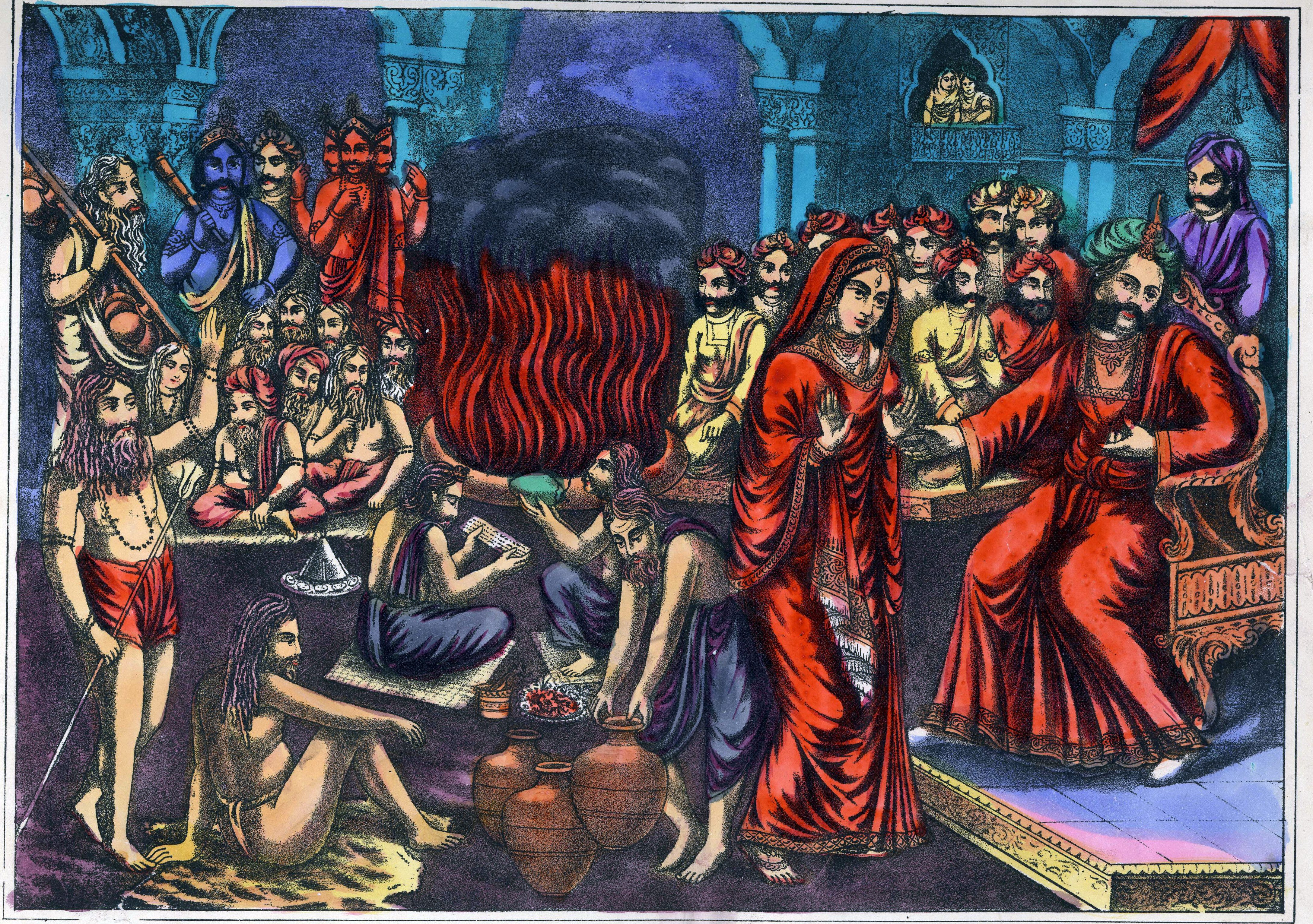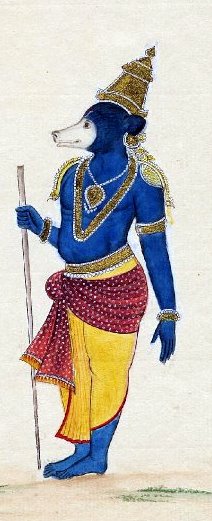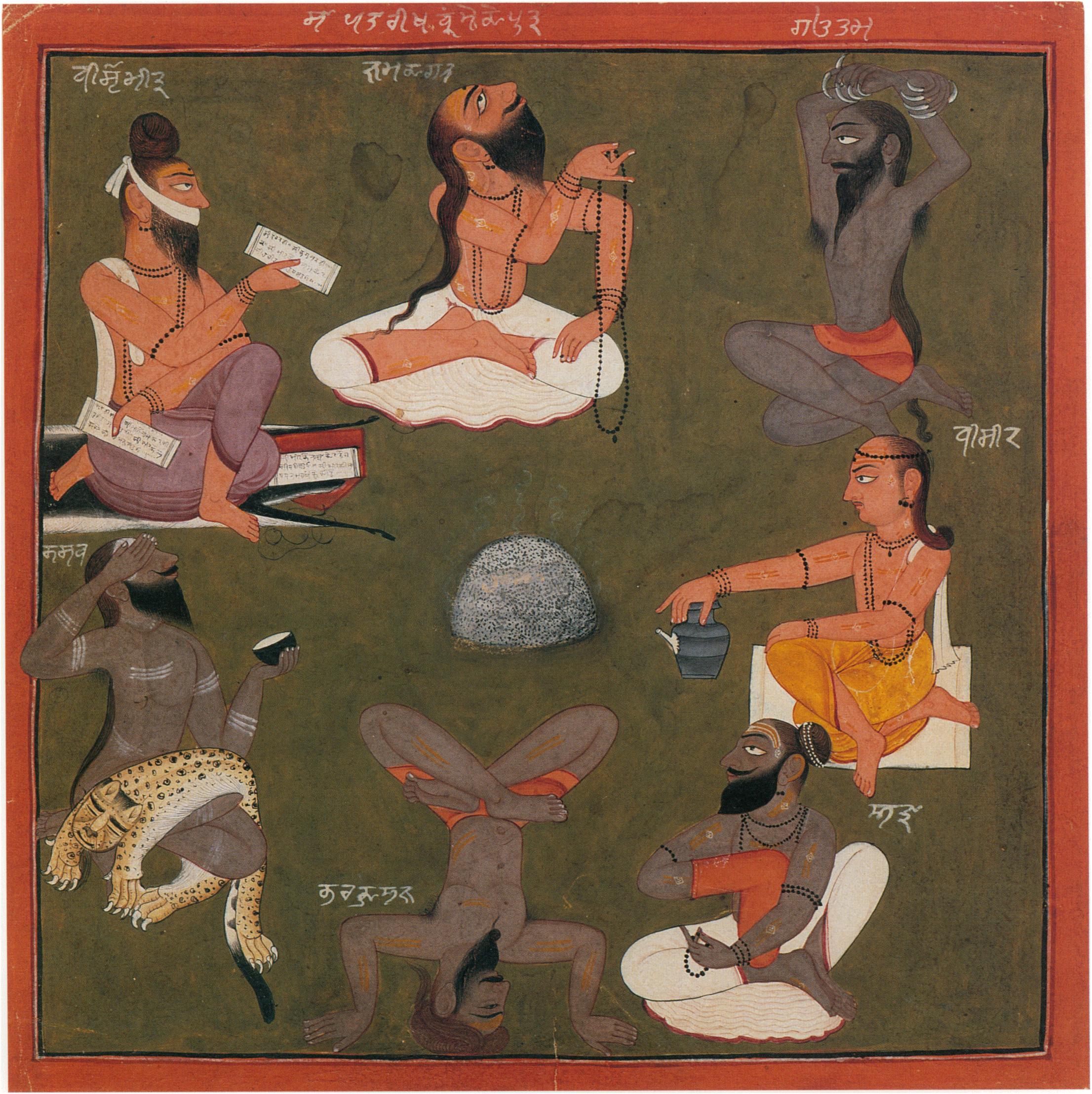|
Mānasaputra
Manasaputras (, ) are a class of beings in Hinduism, referring to the 'mind-children' or the 'mind-born' sons of Brahma. In Hinduism, Brahma is believed to have created a number of children from his mind. Sometimes, these children of the mind are stated to be identical to the Prajapatis, the progenitors of all beings in each creation. The Manasaputras are believed to have created the first man, Svayambhuva Manu, and the first woman, Shatarupa, who had five children, who went on to populate the earth. Lists According to the Vishnu Purana, the nine manasaputras of Brahma are: Bhrigu, Pulastya, Pulaha, Kratu, Angiras, Marichi, Daksha, Atri, and Vashistha. These sages are referred to as the Brahmarshis. According to the Bhagavata Purana, some of the manasaputras are: Angiras, Atri, Pulastya, Marichi, Pulaha, Jambavan, Bhrigu, Vashistha, Daksha, Narada, Chitragupta, the Four Kumaras, Himavat, and Shatarupa. See also * Atharvan *Saptarishi *Prajapati *Chitragupta *the Fou ... [...More Info...] [...Related Items...] OR: [Wikipedia] [Google] [Baidu] |
Shatarupa
Shatarupa () is the daughter of the creator deity, Brahma. According to '' Brahma Purana'', Shatarupa is regarded as the first woman to be created by Brahma, marrying Manu, the first man. Their descendants are called ''manushya'', the Sanskrit term for mankind. Literature The Bhagavata Purana mentions the birth of Shatarupa, and her marriage to Manu: In other texts, it is the manasaputra, the mind-born children of Brahma, who are believed to have created the first man, Svayambhuva Manu, and the first woman, Shatarupa. Shatarupa marries Svayambhuva, and the couple had five children — two sons, Priyavrata and Uttānapāda, and three daughters, Ākūti, Devahūti, and Prasuti.Dipavali Debroy, Bibek Debroy (1992). ''The Garuda Purana''. p. 136. ″''Manu and Shatarupa had two sons named Priyavrata and Uttanapada and three daughters named Prasuti, Akuti and Devahuti''." Manu handed over his first daughter Ākūti to the sage Ruci, the middle daughter, Devahūti, to the ... [...More Info...] [...Related Items...] OR: [Wikipedia] [Google] [Baidu] |
Brahma
Brahma (, ) is a Hindu god, referred to as "the Creator" within the Trimurti, the triple deity, trinity of Para Brahman, supreme divinity that includes Vishnu and Shiva.Jan Gonda (1969)The Hindu Trinity, Anthropos, Bd 63/64, H 1/2, pp. 212–226.Jan Gonda (1969)The Hindu Trinity, Anthropos, Bd 63/64, H 1/2, pp. 218–219. He is associated with creation, knowledge, and the ''Vedas''. Brahma is prominently mentioned in Creation myth, creation legends. In some ''Puranas'', he created himself in a golden embryo known as the Hiranyagarbha. Brahma is frequently identified with the Rigvedic deities, Vedic god Prajapati.;David Leeming (2005), The Oxford Companion to World Mythology, Oxford University Press, , page 54, Quote: "Especially in the Vedanta Hindu Philosophy, Brahman is the Absolute. In the Upanishads, Brahman becomes the eternal first cause, present everywhere and nowhere, always and never. Brahman can be incarnated in Brahma, in Vishnu, in Shiva. To put it another way, eve ... [...More Info...] [...Related Items...] OR: [Wikipedia] [Google] [Baidu] |
Svayambhuva Manu
Svayambhuva Manu () is the first of the fourteen Manus, the first man of a Yuga in Hindu cosmogony. He is the manasaputra (mind-born son) of Brahma and husband of Shatarupa, the first woman.Devi Bhagavata Purana by Swami Vijñanananda ook 10 Chapter 1 - On the story of Svāyambhuva Manu, www.wisdomlib.orgThe Agni Purana by N. Gangadharan, Chapter 18 - Genealogy of Svāyambhuva Manu, www.wisdomlib.org He is stated to have divided the s into ... [...More Info...] [...Related Items...] OR: [Wikipedia] [Google] [Baidu] |
Bhrigu
Bhrigu (, ) is a rishi in Hindu tradition. He is one of the seven great sages, the Saptarshis, and one of the many Prajapatis (the facilitators of creation) created by Brahma. He was the first compiler of predictive astrology and also the author of '' Bhrigu Samhita'', an astrological ( jyotisha) classic. Bhrigu is considered a manasaputra ("mind-born son") of Brahma. The adjectival form of the name, '' Bhārgava'', is used to refer to the descendants and the school of Bhrigu. According to ''Manusmriti'', Bhrigu was a compatriot and companion of Svāyambhuva Manu, the progenitor of humanity. Along with Manu, Bhrigu made important contributions to the ''Manusmṛti'', which was constituted out of a sermon to a congregation of saints in the state of Brahmavarta, after the great floods in this area. As per the ''Skanda Purana'', Bhrigu migrated to Bhrigukaccha, modern Bharuch, on the banks of the Narmada river in Gujarat, leaving his son Chyavana at Dhosi Hill. According to ... [...More Info...] [...Related Items...] OR: [Wikipedia] [Google] [Baidu] |
Pulastya
Pulastya (Sanskrit: पुलस्त्य) is one of the ten Prajapati, and one of the mind-born sons of Brahma in Hinduism. He is also one of the Saptarishi (Seven great sages) in the first age of Manu, the Manvantara.Inhabitants of the Worlds Mahanirvana Tantra, translated by Arthur Avalon, ( Sir John Woodroffe), 1913, Introduction and Preface. The Rishi are seers who know, and by their knowledge are the makers of shastra and "see" all mantras. The word comes from the root rish Rishati-prapnoti sarvvang mantrang jnanena pashyati sangsaraparangva, etc. The seven great Rishi or saptarshi of the first manvantara are Marichi, Atri, Angira, Pulaha, Kratu, Pulatsya, and Vashishtha. In other manvantara there are other ''saptarishi''. ... [...More Info...] [...Related Items...] OR: [Wikipedia] [Google] [Baidu] |
Kratu
Kratu () is described as one of the manasaputras, the mind-born children of the creator deity, Brahma, in Hinduism. He is also a rishi, who appears in two different ages. He is considered to be one among the seven great sages of the age of the first Manu, the Saptarishis, believed to have originated from the mind of Brahma. In another legend, he is believed to have been born from his father's left eye. Legend In the Svayambhuva Manvantara, Kratu is a Prajapati, a son of Brahma. He is also the son-in-law of Prajapati Kardama. His wife is named Kriya. It is said that he has 60,000 children. Their name is included in the eighth book of the Rigveda. Kratu also has two sisters, Punya and Satyavati. He is also stated to be married to Santati in the Puranas, and the pair has sixty thousand children, called the Balakhilyas, who were each of the size of a thumb, but possessed great mastery over the senses. According to the ''Mahabharata'', while helping the sage Kashyapa with a sa ... [...More Info...] [...Related Items...] OR: [Wikipedia] [Google] [Baidu] |
Daksha
Daksha ( ,) is a Hindu god whose role underwent a significant transformation from Vedic mythology, ''Vedic'' to Itihasa-Purana, ''Itihasa-Puranic'' mythology. In the ''Rigveda'', Daksha is an ''Adityas, aditya'' and is associated with priestly skills. In the epics and Puranas, ''Puranic'' scriptures, he is a Mānasaputra, son of the creator-god Brahma and one of the ''Prajapati#"Prajapati" as a title, Prajapati'', the agents of creation, as well as a divine king-rishi. He is the father of many children, who became the progenitors of various creatures. According to one legend, a resentful Daksha conducted a Daksha yajna, yajna (fire-sacrifice), and deliberately did not invite his youngest daughter Sati (Hindu goddess), Sati and her husband Shiva. In the Linga Purana, for insulting Shiva during this event, which caused Sati to self-immolate in fury, he was beheaded by Virabhadra, an attendant of Shiva. He was later resurrected with the head of a goat. Many ''Puranas'' state that ... [...More Info...] [...Related Items...] OR: [Wikipedia] [Google] [Baidu] |
Jambavan
Jambavan (, ), also known as Jambavanta (, ), is the king of the bears in Hindu texts. He emerged from the mouth of Brahma when the creator deity yawned. He assisted Rama, the 7th avatar of Vishnu in his quest to save his wife Sita from the rakshasa king Ravana. In the Ramayana, he helps Hanuman realise his potential, just before his famous leap over to the island of Lanka.Patricia Turner, Charles Russell Coulter. ''Dictionary of ancient deities''. 2001, page 248 Jambavan was present at the Samudra Manthana, and is supposed to have circled Vamana 21 times in a single leap, when he was acquiring the three worlds from Mahabali. He is considered to be one of the strongest divine beings of Hinduism. Jambavan, together with Parashurama and Hanuman, is considered to be one of the few to have been present for the birth of both Rama and Krishna. His daughter Jambavati was married to Krishna. Nomenclature Jambavan is also known as: * Jambavantan * Jambavanta (জাম্বৱ� ... [...More Info...] [...Related Items...] OR: [Wikipedia] [Google] [Baidu] |
Saptarishi
The Saptarshi ( ) are the seven seers of ancient India who are extolled in the Vedas, and other Hindu literature such as the Skanda Purana. The Vedic Samhitas never enumerate these rishis by name, although later Vedic texts such as the Brahmanas and Upanisads do, so these constellations are easily recognizable. Hindu sacred text An early prototype of the "Saptarishi" concept may stem from the six families associated with the six "Family Books" in the Rigveda Samhita (Mandalas 2–7 in ascending order: Gṛtsamāda, Viśvāmitra, Vāmadeva, Atri, Bharadvaja, Vasiṣṭha). While not a "Family Book", Mandala 8 is mostly attributed to Kaṇva, who could be considered the 7th prototypical Saptarishi. The earliest formal list of the seven rishis is given by Jaiminiya Brahmana 2.218–221: Agastya, Atri, Bhardwaja, Gautama, Jamadagni, Vashistha, and Vishvamitra followed by Brihadaranyaka Upanisad 2.2.6 with a slightly different list: Atri, Bharadvaja, Gautama ... [...More Info...] [...Related Items...] OR: [Wikipedia] [Google] [Baidu] |
Atharvan
Atharvan ( , nominative singular: अथर्वा ) is a legendary Vedic sage (rishi) of Hinduism, who along with Angiras, is supposed to have authored (" heard") the Atharvaveda. He is also said to have first instituted the fire-sacrifice or yajña. Sometimes he is also reckoned among the seven seers, the Saptarishi. His clan is known as the Atharvanas. Atharvan married Shanti, daughter of Prajapati Kardama, and had a great sage Dadhichi as a son. He is referred to as a member of the Bhrigu clan. According to the Mundaka Upanishad and other texts, he was the eldest son and ( Manasaputra) born from mind of the creator deity, Brahma. Etymology Vedic ''atharvan'' is cognate with Avestan ''āθrauuan'' / ''aθaurun'', "priest", but the etymology of the term is not yet conclusively established. It has been traditionally thought to be etymologically related to the Avestan Avestan ( ) is the liturgical language of Zoroastrianism. It belongs to the Iranian languages, ... [...More Info...] [...Related Items...] OR: [Wikipedia] [Google] [Baidu] |
Himavat
Himavat () is the personification of the Himalayan mountains in Hinduism. He is the guardian deity of the Himalayas, and finds mention in the epic '' Mahabharata'' and other Hindu scriptures. Nomenclature Various Hindu scriptures refer to the personification of the Himalayas by different names, and hence Himavat is also called Himavant (Sanskrit: हिमवन्त, lit. ''icy),'' Himavān (Sanskrit: हिमवान्, lit. ''snowy''), Himaraja (Sanskrit: हिमराज, lit. ''king of snow''), and Parvateshwara (Sanskrit: पर्वतेश्वर, lit. ''god of mountains''). Legend Himavat fathered Ganga, the river goddess, as well as Ragini, and Parvati, the second consort of Shiva. His wife and queen consort is the Vedic goddess Mainavati, the daughter of Mount Meru, according to the Ramayana, or is the daughter of Svadhā and her husband Kavi, a member of the class of Pitṛs, as per some other sources like the Vishnu Purana. The Shiva Purana desc ... [...More Info...] [...Related Items...] OR: [Wikipedia] [Google] [Baidu] |
Four Kumaras
The Kumaras are four sages (''rishis'') from the Puranic texts of Hinduism who roam the universe as children, generally named Sanaka, Sanandana, Sanatana, and Sanatkumara. They are described as the first mind-born creations and sons of the creator-god Brahma. Born from Brahma's mind, the four Kumaras undertook lifelong vows of celibacy ( brahmacharya) against the wishes of their father. They are said to wander throughout the materialistic and spiritualistic universe without any desire but with the purpose of teaching. All four brothers studied Vedas from their childhood, and always travelled together. The ''Bhagavata Purana'' lists the Kumaras among the twelve '' mahajanas'' (great devotees or bhaktas) who although being eternally liberated souls from birth, still became attracted to the devotional service of Vishnu from their already enlightened state. They play a significant role in a number of Hindu spiritual traditions, especially those associated with the worship of Vi ... [...More Info...] [...Related Items...] OR: [Wikipedia] [Google] [Baidu] |





